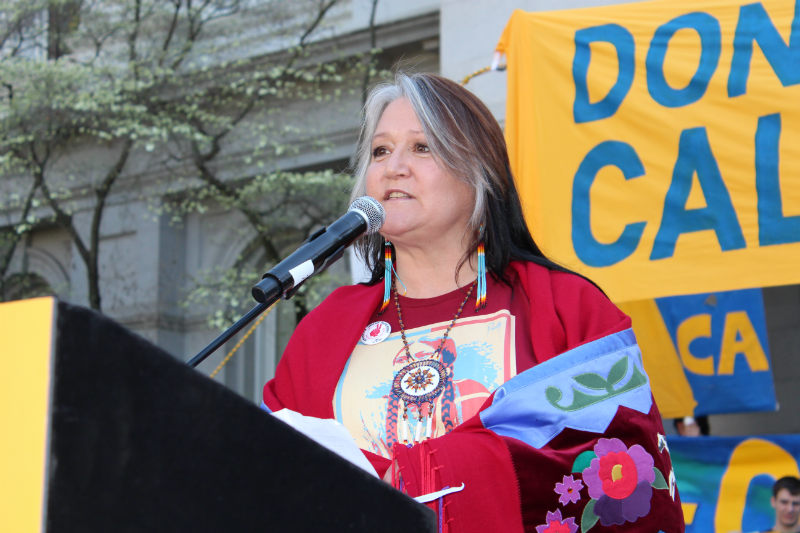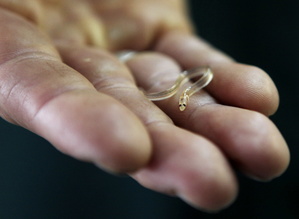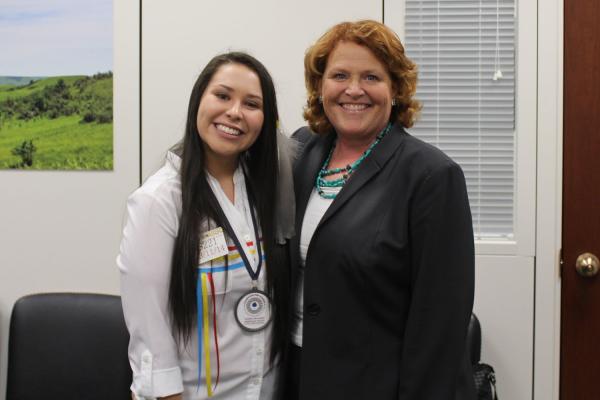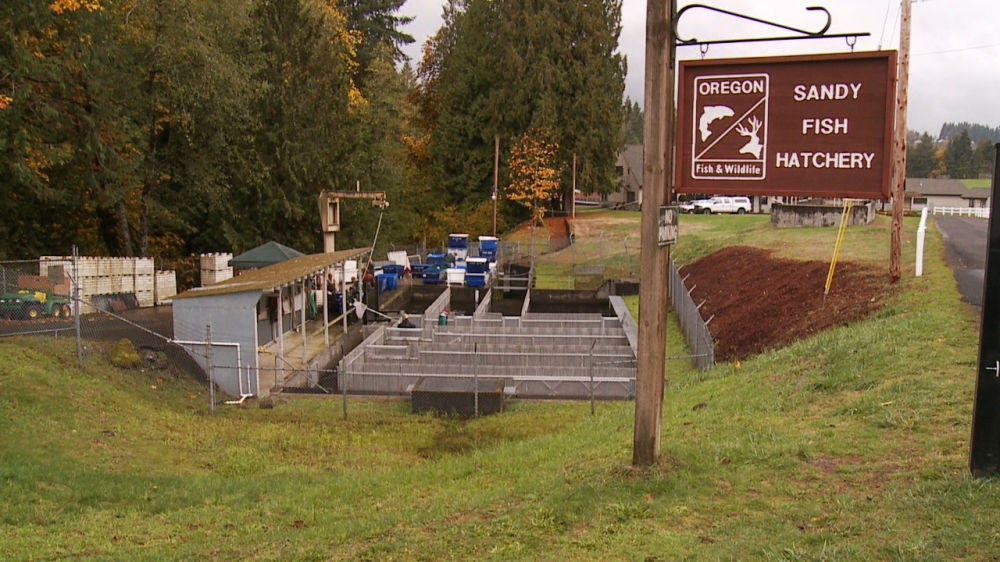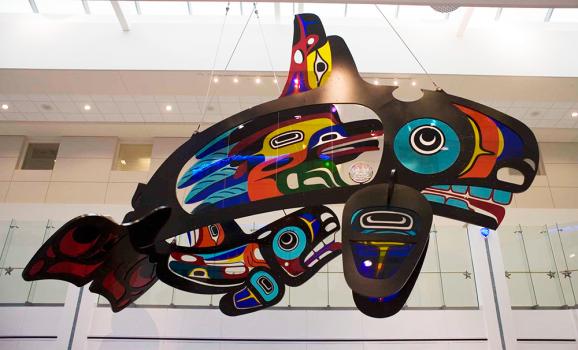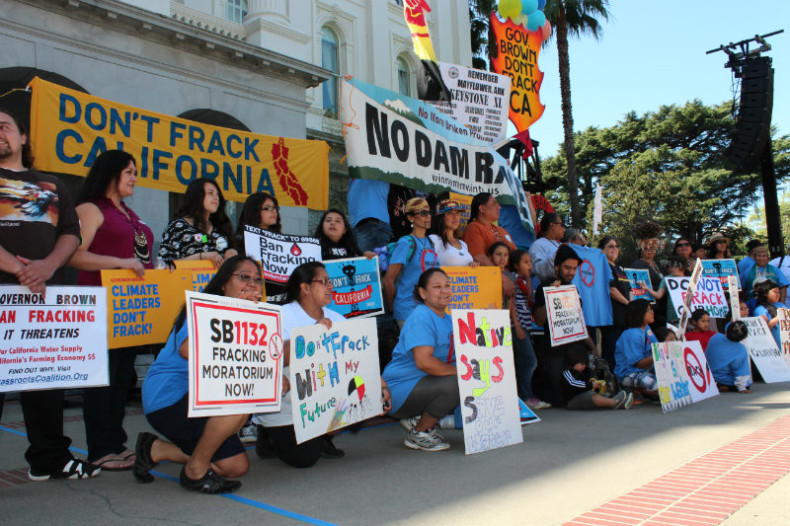
By Dan Bacher, IC Magazine
Hundreds of Indigenous Peoples from the state and throughout the country gathered with a crowd of over 4000 people at the State Capitol in Sacramento on March 15 to send a clear message to Governor Brown: ban fracking, an environmentally destructive oil extraction practice that pollutes groundwater, rivers and the oceans.
The large Tribal contingent included members of the Miwok, Maidu, Winnemem Wintu, Yurok, Karuk, Hoopa Valley, Ohlone, Pit River, Cahto, Round Valley, Tule River, Pomo and Chumash Nations and other Tribes from throughout the state, as well as members of the Dakota, Lakota Sioux, indigenous communities, native organizations and activists in the Idle No More Movement and Klamath Justice Coalitions. Many Tribal representatives emphasized the direct connection between fracking and the Shasta Dam raise and the Governor’s peripheral tunnels plan, which will provide water for fracking.
“We should call the Governor ‘Westlands’ Brown,” quipped Chook Chook Hillman, a member of the Karuk Tribe and the Klamath Justice Coalition that has organized many direct action protests to remove the Klamath dams, halt the violation of tribal gathering rights under the Marine Life Protection Act (MLPA) Initiative to create so-called “marine protected areas,” and to stop the Westlands Water District legal attempt to raid Trinity River water.
“Brown is setting aside all the environmental rules in order to ship water south,” said Hillman, who held a banner proclaiming, “Stop Fracking Around – Undam the Klamath,” with other members of Klamath Justice Coalition. “Fracking will take good water, put chemicals in it and then it will come out toxic forever. Fracking will affect all us – fracking is a terrible use of water, water that could be used for people and fish.”
The event, organized by the Californians Against Fracking, featured diverse speakers including environmental justice advocates, farmers, student activists and other groups opposed to fracking. Hundreds of organizations, ranging from grassroots groups to large NGOs, helped to organized the rally.
Chief Caleen Audrey Sisk, Tribal Chief and Spiritual Leader of the Winnemem Wintu, led the opening ceremony and prayer. She took aim at the Governor’s peripheral tunnels plan – the “Brown Water Plan,” as she calls it.
She emphasized, “Here at the Capitol a lot of Brown water planning is going on. This water is our medicine – it comes from the sacred places where the medicine comes from. We struggle to continue to take care of our waters – there is no other place we can go to practice our religion.”
Caleen Sisk, Chief and Spiritual Leader of the Winnemem Wintu Tribe, opens the rally with a ceremony and prayer. (Photo by Dan Bacher)
After the rally was over she led a group of Winnemem Wintu and their supporters down to the Sacramento River at Miller Park take the “Water Challenge” to defend waters, rivers and fish population. Around 20 people cautiously waded into and then swam in the muddy waters.
“When we accept the winter water challenge and go down to our rivers, springs, lakes and oceans to make a heartfelt commitment and challenge others to do the same it makes the waters happy,” she said. “All over California the water ways are waking up with good blessings! Now accept the challenge to take the message you got to the Capitol and tell the world…no fracking chance will your Brown Water Plan destroy our sacred waters.”
Warrior Woman, a Dakota Indian woman holding a sign saying, “Mother Earth Does Not Negotiate,” said, “We’re here to stop fracking and the rape of Mother Earth. Water is the life blood of Mother Earth. The governmental system can’t continue to oppress the people and Mother Earth any longer.”
Mike Duncan, Round Valley Reservation Tribe member, described fracking as “another broken treaty.”
“I’m here for tribal water waters and to stop the raising of Shasta Dam. It’s the future – it’s our responsibilities as tribal people to stop fracking. Fracking is another broken treaty as far as I am concerned,” he said.
Penny Opal Plant, an organizer of Idle No More, pointed out that the battle against fracking and other destructive methods of oil and gas extraction is a worldwide struggle, including Lakota resistance to the XL pipeline, the resistance of Canadian First Nations to fracking and battles of indigenous people against destructive resource extraction throughout Latin America.
“We are not Mother Earth’s failed experiment. We are her immune system. All of the our two legged relatives must stand up for Mother Earth,” she stated.
Penny Opal Plant of Idle No More explained how California fracking occurs in the context of indigenous struggles against fracking across the globe. (Photo by Dan Bacher)
She noted that the oil industry is planning ship dangerously explosive crude oil through Richmond, California – and vowed direct action to stop the trains.
“We will put our bodies on the line and we may have to sit in front of the those trains,” Plant said.
“What time is it?,” she shouted to the crowd. “It’s time to transition!”
In a press release before the rally, Corrina Gould, Elder, Chochenyo/Karkin Ohlone, stated, “We are the ancestors of the future and it is our responsibility to be the care takers of the earth, as was given to us in our original teachings by our ancestors. We must not allow the continuous devastation and degradation of our Mother, Earth. We must be the voices for our children and our grandchildren. Fracking must stop by any means necessary.”
“Fracking” is a method of oil and gas production that involves blasting millions of gallons of water, mixed with sand and toxic chemicals, under high pressure deep into the earth to extract oil and gas but it can also pollute local air, water, and endanger the lives of people and wildlife, according to Corine Fairbanks, director of American Indian Movement Southern California Chapter.
Fracking exposes people to radioactivity and numerous toxic chemicals such as lead, arsenic, methanol, and benzene. The chemicals used in fracking have been linked to infertility, birth defects and cancer.
“Fracking is also known to trigger seismic activity and earthquakes,” said Fairbanks. “Anti-Fracking efforts have been led by California Native Nations throughout the state and on February 28th, 2014 the Los Angeles City Council passed a ban on fracking within its jurisdiction. This makes Los Angeles the first oil-producing city in California to call a halt to the practice.”
Fracking has been documented in 10 California counties — Colusa, Glenn, Kern, Monterey, Sacramento, Santa Barbara, Sutter, Kings and Ventura. Oil companies have also fracked offshore wells in the ocean near California’s coast, from Seal Beach to the Santa Barbara Channel. Fracking may have been used elsewhere in California, since state officials have monitored neither or tracked the practice until recently, according to Fairbanks.
Fairbanks pointed out that Indian people have been fighting against hydraulic fracking and toxic dumping for many years.
“Toxic dumping and hydraulic fracking like efforts have been happening on and around Reservations for decades, causing a multitude of problems for our people; birth defects, and twisted strands of cancer,” said Fairbanks. “ No one took notice or interest when Native people wanted this stopped, now all of a sudden when it is becoming more of threat in non-Native communities, there is alarm and action.”
Gary Mulcahy, a member of the Winnemen Wintu Tribe, emphasized the connection between the raising of Shasta Dam, the peripheral tunnels and building of new dams that many tribal members and Delta folks made with their signs and banners at the event.
“It is interesting how fracking would bring out 4,000 to 5,000 people to a demonstration because this fracking, one way or the other, will hurt the water supply,” he noted. “But when you talk about agribusiness taking water drip by drip and drop by drop by building canals, raising dams or building more dams supposed to supply more water than the system can deliver in the first place, only a few voices are heard like a candle in the darkness.”
“Fracking involves your water from north to south, from east to west, water that is ultimately controlled by big corporations, including agribusiness and oil companies. If fracking is bad, then so is raising dams, building new dams and building the tunnels,” he concluded.
Hopefully, this highly successful rally will be followed by even bigger rallies and demonstrations in Sacramento and throughout the state opposing fracking, the peripheral tunnels, the Shasta Dam raise and the building of new dams.
Adam Scow of Food and Water Watch, one of the co-founders of Californians Against Fracking, said anti-fracking activists will keep building the movement to put pressure on Brown to ban fracking.
“Water is a human right and fracking is a violation of that human right, as are the twin tunnels,” Scow concluded.
For more information, go to: www.californiansagainstfracking.org
Caleen Sisk: “We call to Olebis to look down on us and send down the good blessings. We call on sacred Mt. Shasta to help bless us with this sacred water, so it will continue to bring us and our children’s, children and so on in to the future with good health and long life for all our relations. We are calling on the water and fire spirits to help bring back the balance in our world, as wild salmon, wolves, beavers and giant trees make their way back. We sing to the water that flows from the sacred spring on Buliyum Puyuk (Mt. Shasta) to the ocean and back again…..waters from Mauna Kea come back and answer the call and the lakes of fire send their blessings. We ask the fires inside of Mt Shasta and all the sacred fires inside the mountains of the world to help us bring understanding and balance to our way of life and change our lives to the good again. Bring back the original taste of water to guide the people and all relatives back to healthy thinking and acting. For nothing will be here with out fresh clean healthy WATER. No air can be produced without waters to grow the trees, the Kelp, ……this world was created in the most perfect functioning way…..but now so much destruction and toxic waste ….for mega money for a few. We pray that our words will be heard and the August Fire and Water Ceremony be good in sending our prayers up the Creator!!!”
Background on fracking and oil industry money
For those not familiar with the practice, fracking blasts massive amounts of chemical-laced water into the ground to crack rock formations in order to extract oil and natural gas, according to the Center for Biological Diversity. The process routinely employs numerous toxic chemicals, including methanol, benzene and trimethylbenzene.
Oil companies have also fracked offshore wells over 200 times in the ocean near California’s coast, from Seal Beach to the Santa Barbara Channel, according to a Freedom of Information Act Request and media investigation by the Associated Press and truthout.org last year. WSPA President Catherine Reheis-Boyd served on the MLPA Initiative Blue Ribbon Task Forces during much of the time that this fracking of our marine waters was taking place.
The Center cited two studies documenting the harm fracking poses to human health. Birth defects are more common in babies born to mothers living near fracked wells, according to a new study by researchers at the Colorado School of Public Health. In California, a recent Center report found that oil companies used 12 dangerous “air toxic” chemicals more than 300 times in the Los Angeles Basin over a period of a few months.
Besides posing a big threat to human health, the pollution to California groundwater supplies, rivers and the Delta that will result from fracking and acidization will devastate already imperiled populations of Central Valley Chinook salmon, steelhead, Delta smelt, green sturgeon and other fish species.
The Western States Petroleum Association (WSPA), the most powerful corporate lobbying organization in Sacramento, spent over $4.67 million, more than any other interest group, while lobbying state government in 2013, according to data released by the Secretary State’s Office and compiled by the Capitol Morning Report.
Another oil company giant, Chevron Corporation and its subsidiaries, spent $3.95 million, the third most spent by any group on lobbying state government in 2013. Chevron also spent much of its money on lobbying against bills that would ban or regulate fracking in California.
Since it is the most powerful corporate lobby in Sacramento, the oil industry is able to wield enormous influence over state and federal regulators and environmental processes. The result of this inordinate money and influence is the effective evisceration of the Marine Life Protection Act of 1999 during the MLPA Initiative process and the signing of Senator Fran Pavley’s Senate Bill 4.
A report recently released by the American Lung Association revealed that the oil industry lobby spent $45.4 million in the state between January 1 2009 and June 30, 2013. The Western States Petroleum Association (WSPA) alone has spent over $20 million since 2009 to lobby legislators. (http://blog.center4tobaccopolicy.org/oil-lobbying-in-california)
For more information on oil industry power and money, go to: http://www.counterpunch.org/2013/11/08/sacramento-a-capital-awash-in-oil-money/


